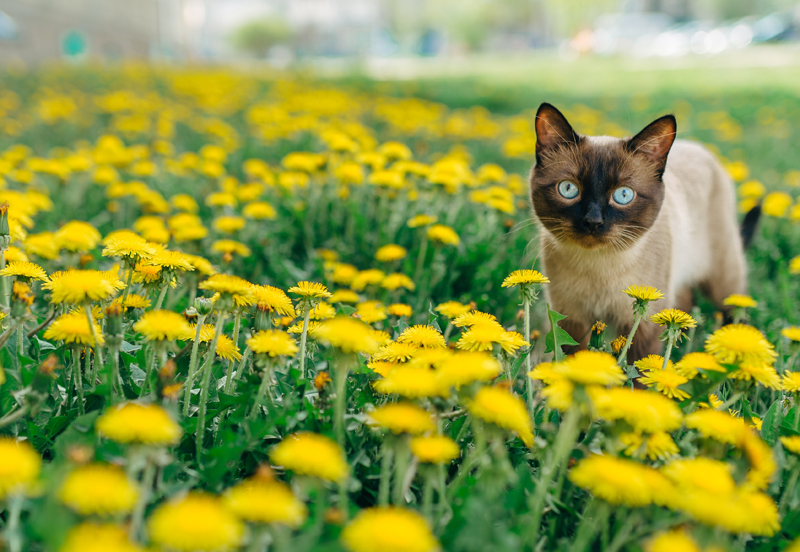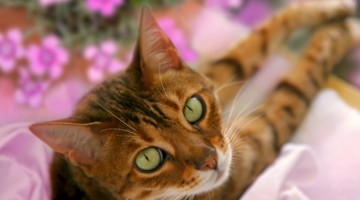Are essential oils safe for felines? Not all experts have the same answer, but there are ways your kitty can enjoy the benefits of aromatherapy without risk.
Can essential oils be used safely with cats? Some experts sound a definite “no” while others offer suggestions for limited use. Veterinarians have safely and successfully used aromatherapy with cats in specific clinical situations, although lay use is typically discouraged due to risk factors such as the chemical composition and/or quality of the oils. But there are other options.
What makes them toxic to cats?
Whether topically applied, ingested or inhaled, essential oils are absorbed into the bloodstream and metabolized in the liver. Hepatic glucuronidation is an important detoxification mechanism present in most mammals – but not cats. According to Kristin Leigh Bell in Holistic Aromatherapy for Animals (Findhorn Press, 2002), cats are not well-equipped to metabolize essential oil components because they lack the liver enzyme glucuronyl transferase.
In Veterinary Herbal Medicine (Elsevier Health Sciences, 2007), authors Susan G. Wynn and Barbara Fougère list the following essential oils potentially toxic to cats: basil, birch, clove, hyssop, oregano, pennyroyal, savory, tansy, tarragon, tea tree, thuja and wintergreen. They note that tea tree toxicosis has been found in some cats, while the salicylates found in birch and wintergreen are one of the substances that cats metabolize slowly, making them more susceptible to toxicity. Citrus oil extracts such as d-limonene can also be harmful to cats. Used in shampoos, insect repellents, food additives and cleaning products, these substances can cause feline liver damage.
The case for hydrosols
Hydrosols, also called hydrolats or hydrolates, contain the water-soluble parts of steam-distilled plants as well as minute amounts of essential oil components. Because toxicology studies have found certain components, such as monoterpene alcohols and their metabolites, in the urine of cats exposed to these substances, it appears they can tolerate hydrosols better than essential oils. “The hydrophilic molecules [readily attracted to water] that are found primarily in hydrosols are more easily metabolized by mammals than lipophilic molecules [readily attracted to fat], since they do not have to be changed into water-soluble form for urinary excretion,” says aromatherapist Robert Tisserand.
Hydrosols contain the watersoluble parts of steam-distilled plants as well as minute amounts of essential oil components.
Lia Whitmore, a certified clinical aromatherapist and national certified master groomer with over 20 years of experience, believes hydrosols are considerably safer for cats, but does not advise their oral use unless under the close supervision of a qualified veterinarian.
 Conversely, clinical aromatherapist Suzanne Catty says she has never had a problem with using hydrosols orally. “After 15 years of using hydrosols on felines both topically and internally in cases like dental problems, I have seen no negative effects.” Suzanne’s extensive research has shown that it is safe to use authentic, properly stored, fresh hydrosols that are free of preservatives, alcohol and stabilizers. Using certified organic and sustainably wildcrafted hydrosols insures no fertilizer or pesticide contamination. “Cats have been known to ‘ask’ their owners for a hydrosol,” says Suzanne. “When it comes to hydrosols with functions such as flea repellent blends, cats seem to recognize their benefits.”
Conversely, clinical aromatherapist Suzanne Catty says she has never had a problem with using hydrosols orally. “After 15 years of using hydrosols on felines both topically and internally in cases like dental problems, I have seen no negative effects.” Suzanne’s extensive research has shown that it is safe to use authentic, properly stored, fresh hydrosols that are free of preservatives, alcohol and stabilizers. Using certified organic and sustainably wildcrafted hydrosols insures no fertilizer or pesticide contamination. “Cats have been known to ‘ask’ their owners for a hydrosol,” says Suzanne. “When it comes to hydrosols with functions such as flea repellent blends, cats seem to recognize their benefits.”
Staying on the safe side
As a general guideline, Robert believes that essential oils making up no more than 1% of the product are generally safe for cats as long as they are used only occasionally. Registered aromatherapist Lisa Davis is extremely cautious when using essential oils with her cats. “I never apply them directly to the cat, generally offering them from a distance through diffusion only.” When diffusing, maintain good ventilation and fresh air circulation. Make sure your cat can leave the area that is being diffused. And reduce your cat’s exposure by diffusing for specific reasons, and only when necessary. “Diffusing for 15 minutes just three to four times a day can be adequate essential oil therapy,” says Bev Day, president of Rocky Mountain Aromatherapy Institute.
While not all cats may react negatively to all essential oils, exercise caution and watch your kitty for subtle changes in behavior and/or a lack of energy. Using essential oils around cats can be managed – and it’s generally believed that limited exposure to pure quality essential oils is better than using synthetic or adulterated fragrances. If you’re in any doubt, consult with a professional aromatherapist, or opt for hydrosols.







No Comment